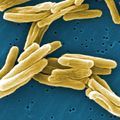Text to go here...
 GM mice have helped identify a key enzyme responsible for destroying lung tissue in tuberculosis (TB). Medicines that inhibit this enzyme are already available, so may be able to reduce deaths from TB.
GM mice have helped identify a key enzyme responsible for destroying lung tissue in tuberculosis (TB). Medicines that inhibit this enzyme are already available, so may be able to reduce deaths from TB.
A third of the world's population is infected with TB, and almost 2 million people die from it every year. Standard treatment has remained unchanged for 35 years, and no treatments exist to prevent the lung destruction caused by TB.
TB is caused by the bacterium M tuberculosis. The infection destroys patients' lung tissue, causing them to cough up the bacteria, which then spread through the air and can be inhaled by others. The mechanism behind this lung damage is poorly understood. Patients require at least six months of antibiotic treatment, but resistant strains of the bacterium are becoming increasingly common.
The new research shows that in patients with TB, there is an increase in levels of an enzyme called MMP-1 in their lungs. When the researchers infected human immune cells with TB in the lab, they found that the cells greatly increased production of this enzyme.
Because mice do not have the enzyme in their lungs, the researchers developed a GM mouse with human MMP-1. When these mice were infected with TB, enzyme levels increased significantly and the infection led to lung damage similar to that seen in humans with TB. A cancer medicine already proven to be safe in humans was effective at suppressing MMP-1 activity driven by TB infection in human cells.
The findings suggest that similar medicines might prevent lung damage in TB patients and help limit the spread of the disease. Further studies are planned.
Find out more about the first medicine for TB.
Last edited: 11 January 2022 13:04




